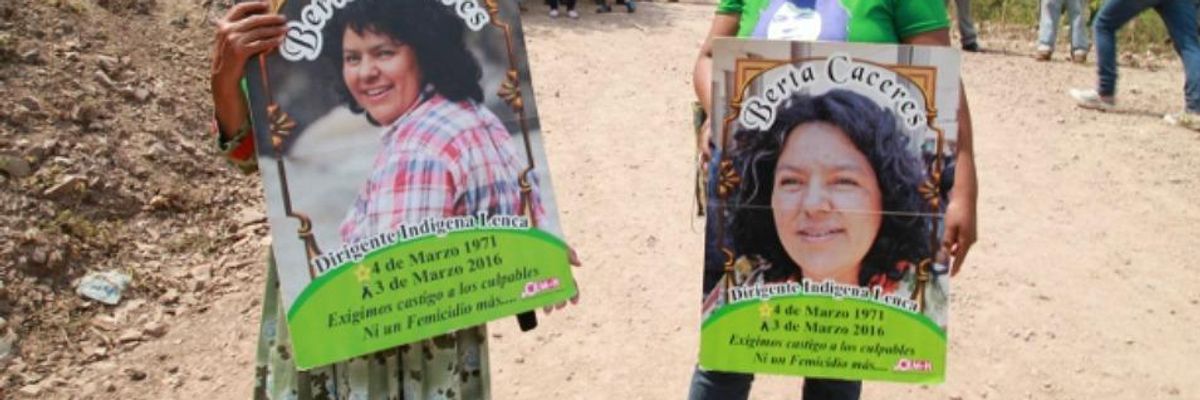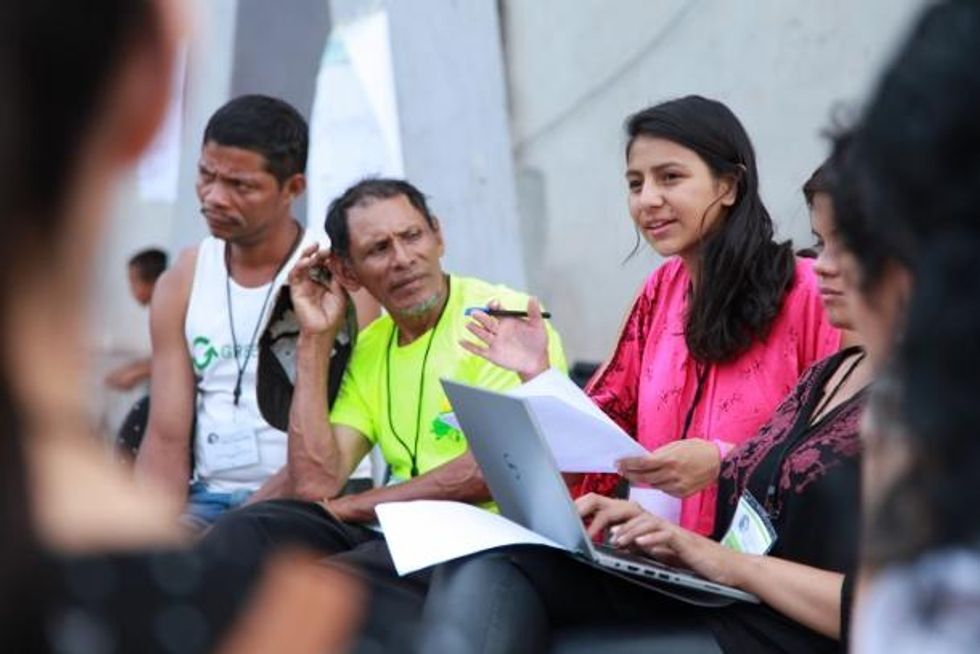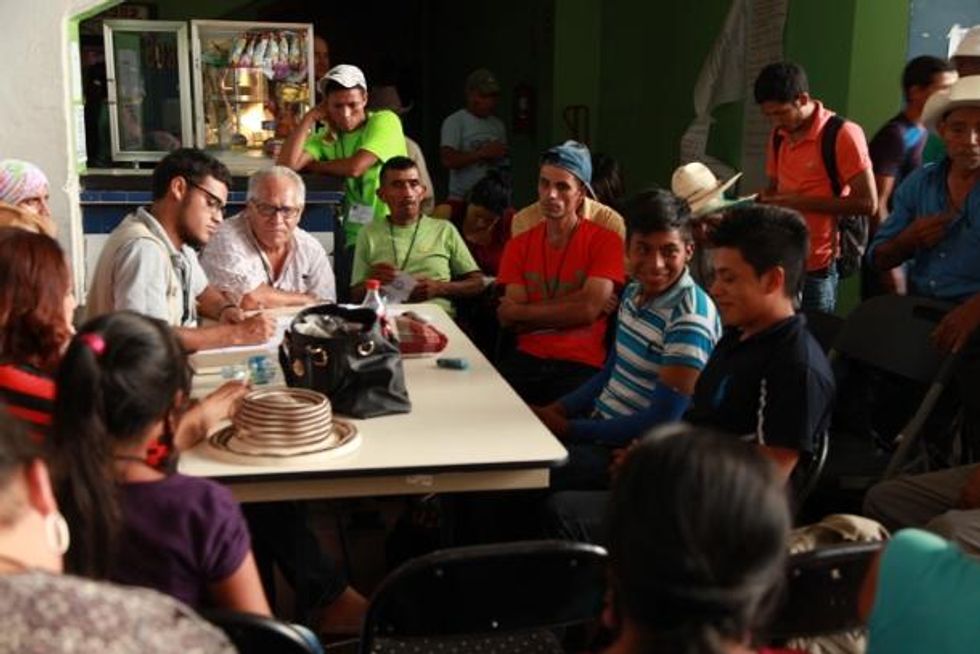Amidst lingering smoke from the morning's ceremony, Garifuna leader Miriam Miranda opened up the space with a welcoming. "We celebrate that you are here with us today to build something real. We don't want our Sister Berta to become an empty word. We don't want her name to become just another slogan."
The space was known as the Nacional de Engenieros Coliseum, a large stadium adorned with sweeping banners representing some of Central America's most prominent social and environmental movements. From April 13-15, roughly 1,300 people gathered here from 20 countries around the world. Named the "Berta Lives International People's Gathering," the three-day event aimed to honor the life and struggle of slain Honduran leader Berta Caceres, affectionately called "Bertita" by those who knew her.
Caceres, a life-long indigenous Lenca activist and co-founder of the Civic Council of Popular and Indigenous Organizations of Honduras, or COPINH, was murdered on March 3 while sleeping in her home in La Esperanza, Intibuca. At least two armed assailants stormed her house, shooting both her and the crime's only witness, Mexican citizen Gustavo Castro Soto, who had arrived the day before for an international workshop on hydroelectric dams. Castro received two bullet impacts, but was able to survive by playing dead. Berta died in his arms minutes later. Her death sparked a global outcry, highlighting some of the most sinister realities of repression and impunity in the Central American country that has been deemed the most violent place for environmental activists.
"The first goal of the gathering is to ensure justice is found for Berta's assassination," said Victor Fernandez, the legal representative of COPINH who works on Berta's case on behalf of her family. "Beyond that, we have to make justice for the historical demands that Berta and COPINH have embodied and continue to embody." Fernandez outlined the details of the case. "It's been privatized," he explained. "The victims know nothing about the process, and the public prosecutor's office has declared the case to be a secret. Berta's daughters don't even know the time of their mother's death, because they've been denied access to the autopsy."
Particularly worrisome to human rights organizations was the government's response within the first 48 hours after the murder, in which investigators allegedly tampered with the crime scene and treated COPINH members as suspects, while ignoring the escalating death threats Berta had been receiving for her opposition to Agua Zarca -- a hydroelectric dam project that would have impacted communities surrounding the Gualcarque River.

Daughter of Berta Caceres, Laura Zuniga Caceres, leads a focus group on territorial defense at the "Berta Lives" People's Gathering. (WNV/Beth Geglia)
The dam project is owned by Honduran company Desarrollo Energeticos S.A., widely known as DESA, but financed internationally. One of COPINH's most notable victories was convincing the dam's original funders, the International Finance Corporation of the World Bank and the project's then co-owner, Chinese state-owned company Sinohydro, to withdraw from the project in 2013. This struggle propelled Berta into the international spotlight and won her the prestigious Goldman Award for environmental activists in 2015.
Such recognition has contributed force to the demands of COPINH and Berta's family after her assassination. Leaders globally, including members of the U.S. Congress, have echoed the call for an independent investigation into the murder that would be led by the Inter American Commission for Human Rights, or IACHR, but would have direct prosecutorial powers with the public prosecutor's office. Additionally, letters, phone calls and petitions sent from around the world to Agua Zarca's two current financiers, Finnish finance company FinnFund and Dutch bank FMO, caused both entities to temporarily suspend funding to the project. However, the banks have not withdrawn entirely and work on the dam inches forward. According to Fernandez, the Honduran government has evaded calls for IACHR involvement and has instead sought to legitimize its own investigation through collaborations with other institutions like the FBI and the newly constructed Support Mission Against Corruption and Impunity, or MACCIH.
"Achieving justice for Berta in Honduran courts is an uphill battle," explained Grahame Russell, director of the U.S. and Canadian-based organization Rights Action. "Ultimately the struggle for justice in Honduras goes much further than that, and it goes to, as Berta Caceres and COPINH would say, re-founding the state and society. But that is also a Canadian and U.S. struggle."
Russell, who first met Berta in 1998 when COPINH was coordinating emergency relief efforts in the aftermath of Hurricane Mitch, believes that international solidarity is key to exposing the role of U.S. and Canadian economic interests in upholding repressive governments in Honduras since the 2009 military coup. He came to Tegucigalpa with a delegation comprised of Canadian First Nation leaders to draw these connections.
Shortly after the coup catapulted the country into crisis, Canada signed a free trade agreement with Honduras' post-coup government, and mining companies, largely of Canadian origin, have benefited from post-coup mining law reforms. "They [COPINH] were not only denouncing the coup itself, but they were denouncing the 'Honduras is Open for Business approach' that the coup intentionally opened the door for" explained Russell.
Indeed, the "Berta Lives" international gathering took as its target -- first and foremost -- the extractivist model of development impacting indigenous and rural peoples throughout the region. Breakout sessions held both days drew out common experiences with loss of territorial sovereignty: tourism developments that restrict access to beaches and displace traditional fishing economies, logging that causes deforestation, mining and hydro-dams that threaten community water supplies, and biofuel production that leads to land concentration and conflict. Participants discussed problems such as militarization and criminalization of dissent, and shared strategies for territorial defense.

Discussion sessions at the "Berta Lives" People's Gathering attack issues of militarization, criminalization, and strategies for popular education and communication. (WNV/Beth Geglia)
"The vindication of the fundamental rights of indigenous peoples has been a struggle that we've shared, for example, our right to free self-determination and our right to consultation" said Francisco Rocael, who came to the gathering from Guatemala representing the Council of Mayan Peoples of the Department of Huehuetenango. Similar to Lencan communities that Berta led, the Maya communities of Huehuetenango have staged a long-term opposition to a Spanish-owned hydroelectric project in the town of Barillas that has led to the criminalization of dozens of community members. "We also aspire to a different economic model," Rocael explained, "one that respects both human rights and is in harmony with human nature. I think this was a dream we shared with Berta."
Berta's desire to see radical changes in the structures of power and to build new models for society were expressed in the various forms of activism she led, which included feminist movements against gender-based violence, as well as the fight for a constituent assembly to re-write the Honduran constitution and "refound" the country after the 2009 military coup. Ismael Moreno Coto, known as "Padre Melo," a Honduran priest and radio activist who led the ecumenical ceremony at Bertha's open-air funeral just over a month earlier, attended the gathering to propose what he calls "Plan Sovereignty 2021" in Berta's name. The proposal outlines a five-year plan for building a national platform based on deep participatory democracy and independence from international economic interests.
"Berta Caceres was one of the few people with whom I had shared this idea" Melo said. "We had reached some agreements between us to propose and initiate this together. So, on the very same day as her assassination, I said to myself, 'My homage and my personal promise with Berta has to be to carry forward this proposal.'"
What does it mean to demand justice for Berta Caceres, and what does it mean to say that "Berta lives on"? Combining spiritual ceremonies and political analysis, strategizing and protest, the crowd in Tegucigalpa made clear its intentions to do justice for Berta Caceres by embodying her struggle and values, and striving for the unity for which she is remembered.
"Fundamental justice for Bertha Caceres means that we be able to respond to three big elements that are part of Berta's identity," Melo said. "First, her philosophy, which was anti-systemic, anti-patriarchy, and anti-racist; second, her methodology, which was to be firmly planted in reality and build relationships globally; and third, her mystic, which said that the ancestors have something to say to us. We must listen."
Now, as her surviving daughter, Berta Zuniga Caceres, reminded listeners during her declaration to the gathering, Berta is "one more among our ancestors." It appears that people are listening.



